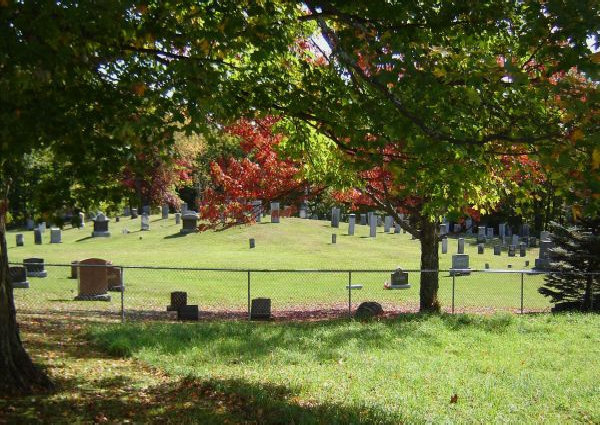7. Cimetière CHAPEL HILL
Le cimetière Chapel Hill, qui date des années 1840, est situé sur le chemin Miltimore à l’intersection du chemin des Marguerites. Une oasis de tranquillité, avec une vue magnifique sur la vallée et les montagnes au loin. Ce lieu se situe près d’un des premiers hameaux de Potton, Meigs’ Corners (1834), d’abord appelé Coit’s Corners (1825). Y reposent les premiers défricheurs du canton, entre autres, Peter Perkins (1767-1848), Anna Ames Perkins (1769-1852), Jonathan Heath, Samuel Clark, David Fullerton, et les membres de la famille Garland. Le révérend Francis Nathaniel Jersey (1797-1860), originaire de Londres et premier Jersey du canton, y est aussi enterré.
Selon Cyrus Thomas, une chapelle baptiste construite vers 1809, d'où le cimetière tire son nom, s'élevait de l'autre côté du chemin, à l'ouest. Les pierres tombales de ce cimetière sont remarquables. Gravées de lettres mises en relief, les pierres de marbre gris ou de granite rouge tranchent avec les plus vieilles inscriptions usées par le temps. C’est la Benevolent Female Society of Potton, première organisation charitable du Canada, qui avait construit cette chapelle.
7. CHAPEL HILL Cemetery
The Chapel Hill Cemetery, found on Miltimore Road at its intersection with Chemin des Marguerites, offers peaceful views of the surrounding valley and distant hills. It is here that some of Potton’s oldest settlers are buried. It is also probable that the oldest settlement in Potton was founded in this general vicinity. It was called Meigs’ Corners (1834) or Coit’s Corners (1825). Cyrus Thomas tells us that “a large building was erected at this place in 1809 or thereabout …” Pioneers such as Peter Perkins, Jonathan Heath, Samuel Clark, David Fullerton, and members of the Garland family, among many others, have found their final resting place upon this hill. The Reverend Francis Nathaniel Jersey (1797-1860), native of London, England, and father of the first Jerseys in Potton, is also buried here.
An interesting feature of the cemetery is that the oldest stones appear to be similar, and were perhaps installed around the same time. Each of these is engraved with flowing script of superior quality. Polished grey marble and stones of red granite, lettered in sharp relief, stand in contrast to the weathered greys and blacks of older markers, inscriptions now barely visible. Chapel Hill Cemetery dates from the 1840’s and takes its name from the meeting house called the Chapel, built around 1809 by the Female Benevolent Society of Potton, the first such charitable organization in Canada. The Chapel Hill Cemetery is also called the Jersey Cemetery.
